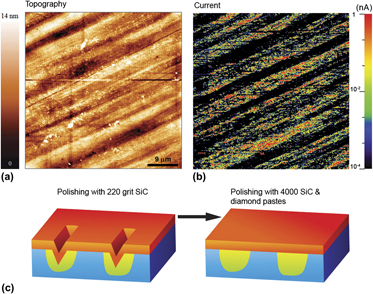No CrossRef data available.
Published online by Cambridge University Press: 11 April 2012

Electrical and electrochemical properties of the passive layer formed on 304L austenitic stainless steel are investigated by means of both conductive atomic force microscopy in air and electrochemical atomic force microscopy in chloride-containing media. The maps of local electrical conductivity of the oxide overlayer exhibit different patterns depending on the surface conditions after mechanical or electrochemical polishing. In particular, the passive film covering strain-hardened regions reveals a higher electrical conductivity. The local enhancement of the electrical conduction is explained by local changes of the stoichiometry of the passive film. Moreover, the highly conductive regions lead to a local breakdown of the native oxide in chloride-containing media and favor the initiation of localized pits.